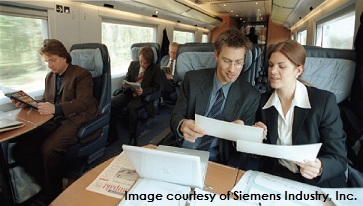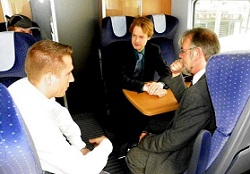High-Speed Rail: Experience the Benefits
Increased Travel Enjoyment
Passenger rail will be a boon not only for business travelers but for pleasure travelers, too. Going to the Indianapolis Zoo? Hop on a train with your companions and chat or play games while you make the journey. Spending a weekend in Chicago? Begin and end your vacation by relaxing on the ride.

Consider the following:
Reduced Congestion.
Congestion on our roads and in our airports contributes to the increase in everyone's stress level. By providing alternative forms of transportation--like high-speed rail, we can dramatically reduce stress and increase traveling pleasure.
Reduced Time Loss.
Whether it's a long wait in the security line or the airport terminal, a traffic jam, weather delays, or simply a long trip, traveling consumes much of our time. High speed passenger trains hold the potential to link urban areas together with faster travel times than car, bus, or plane and by offering more efficient loading and unloading times than crowded airports.
Increased Convenience and Efficiency.
Train travelers arrive in well-connected, central station locations. Not only does this prevent downtown parking headaches and expenses, but it also places passengers at the center of a city's transportation system, providing easy access and connections to transportation modes for travel to final urban destinations. Lockers at major train stations make it easy to store baggage or carry-on items, thus permitting more freedom to move about the city.
Improved Travel Quality.

Traveling by car limits our movement and demands our mental attention and multi-tasking while driving is dangerous. Airplanes and buses present similar problems, requiring passengers to remain in cramped seats and limiting the use of electronic devices. Passenger trains minimize the traveler's discomfort by providing more spacious seating, freedom of movement, and opportunity to engage in a variety of productive activities--or simply to relax. The extra time and freedom of rail travel allows passengers to catch up on work, read a book, play games, or simply enjoy the scenery as it rolls past.
Enhanced Safety and Reliability.
Rail is safer than car travel, and it's less susceptible to severe weather than air travel. In 2009, U.S. air carriers reported 52 fatalities, 3 train passengers lost their lives, and 23,382 people were killed in highway incidents involving passenger cars or light trucks. [1] Weather related delays are frequent occurrences for airline passengers, particularly in winter, and bad weather can seriously impact road conditions and driving visibility.
[1] Information gleaned from the Bureau of Transportation Statistics (BTS). View the report. More meaningful, per-passenger-mile data comparisons are difficult due to the fact that data is reported differently for different modes of transportation: air carrier data is analyzed by departures, aircraft miles, or flight hours; auto accidents are analyzed by vehicle-mile; and train data is analyzed by passenger train-miles--which must be multiplied by the number of cars on each train in order to convert to vehicle-miles. This, combined with the fact that most airplanes and trains transport far more passengers than autos, makes better comparison impossible with the data provided by the BTS.
